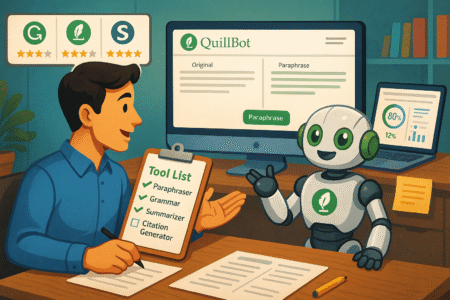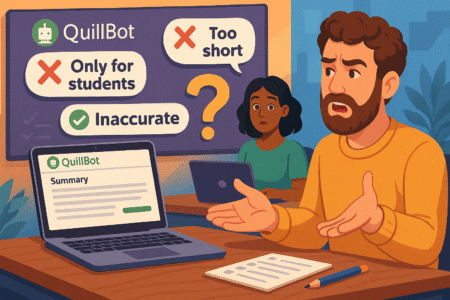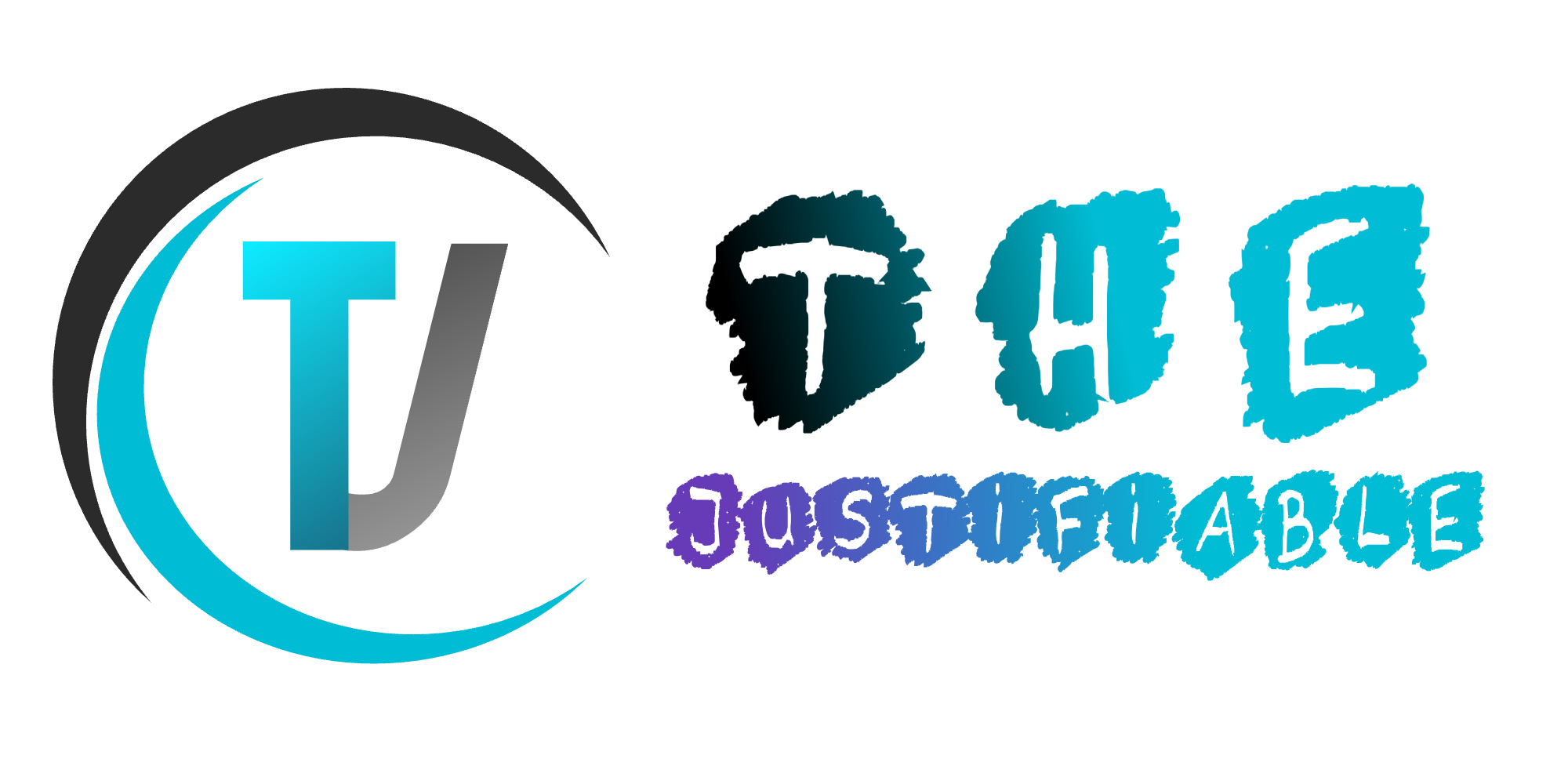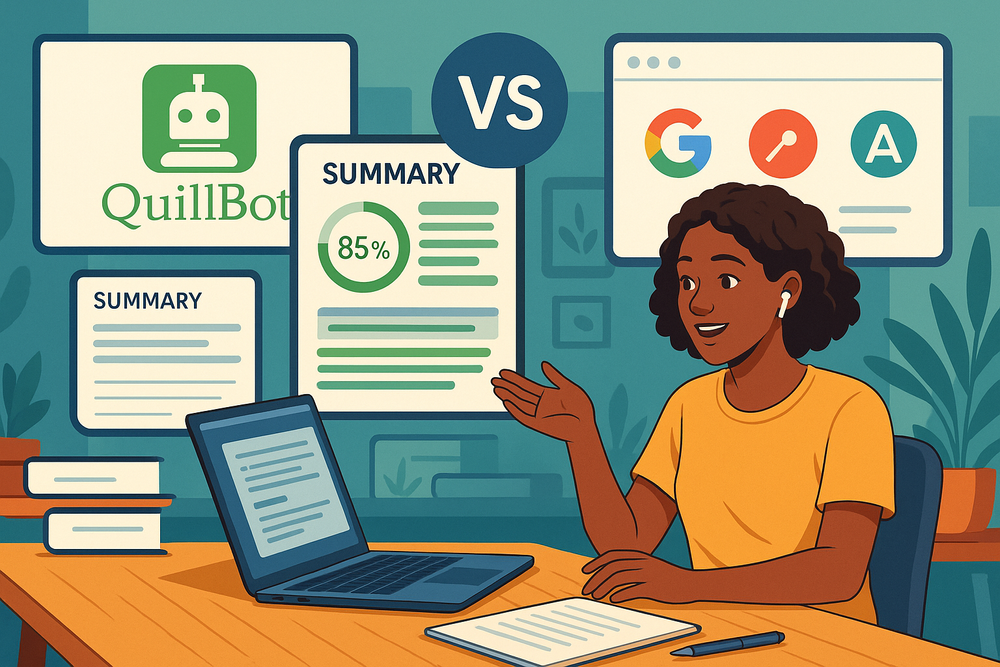Table of Contents
Quillbot Summary completely changed the way I study—and not in a gimmicky or shortcut kind of way. It actually helped me save hours each week by turning overwhelming readings into quick, clear takeaways.
Have you ever stared at a 20-page research article the night before a quiz, wondering how you’ll make sense of it all in time? Or wished you could distill lecture slides into key points without rewriting everything by hand? I’ve been there. And that’s exactly where Quillbot came in.
How does it really work when you’re under pressure? Can it replace traditional note-taking? Does it actually help you retain more while spending less time? I’ll walk you through the exact features, real study situations, and unexpected benefits that made Quillbot summary my go-to study tool.
How Quillbot Summary Transformed My Study Workflow
When I first started using the quillbot summary tool, I had no idea how much time I’d end up saving. Instead of wasting hours stuck in dense academic texts, I was able to get straight to what actually mattered—without losing clarity or depth.
Improved Reading Speed Without Skimming
Before Quillbot, I thought the only way to read faster was to skim, but that always came at the cost of missing context. With the summary tool, I didn’t need to compromise. It condensed full articles into focused summaries that I could digest in minutes, not hours.
Here’s how it changed my reading habits:
- I could load any long-form article or essay into the tool and have a clear summary in under 10 seconds.
- Instead of reading line by line, I started reading smart: focusing on ideas, not filler.
- I gained back at least 2–3 hours per week that I used to spend re-reading materials to understand the core ideas.
It wasn’t about rushing—it was about getting to the heart of the content without cutting corners.
Extracted Key Points From Dense Research Papers
Academic journals are notoriously long-winded and jargon-heavy. Trying to extract what a 40-page paper is actually saying can feel like decoding another language. This is where the quillbot summary became a real game-changer for me.
Using the summary tool:
- I could scan key arguments and findings without having to decipher every technical sentence.
- It allowed me to quickly decide whether a paper was worth reading in full or just referencing.
- I paired it with highlights and notes to build research outlines faster and with more confidence.
It didn’t remove the need for critical thinking—it simply gave me a shortcut to the parts where critical thinking actually mattered.
Made Long Assignments Manageable In Minutes
One of the biggest struggles in school is just getting started—especially when the reading feels impossible. I remember getting a 90-page textbook chapter two days before a midterm and thinking, “There’s no way I’ll finish this.” That’s when I started breaking down the material with Quillbot.
Here’s the workflow I followed:
- I summarized the chapter by section and created a high-level overview in under an hour.
- Then I used that summary as a study roadmap, diving deeper only into sections flagged as “important.”
- I converted the final summary into flashcards and notes with way less effort than traditional methods.
Instead of drowning in information, I found a way to manage it—and still show up prepared.
The Exact Quillbot Features That Saved Me Hours

What really sets the quillbot summary tool apart isn’t just what it does—it’s how it lets you customize the experience. From adjusting length to pairing it with paraphrasing, these features weren’t just helpful—they became essential parts of how I learned.
Summary Tool: Instant Condensing Without Losing Meaning
The core feature is simple but powerful. Drop in any block of text, click summarize, and within seconds, you get a clean, readable breakdown. But what surprised me was how accurate and nuanced the results were.
Why it worked for me:
- It didn’t just shorten—it clarified. I often walked away understanding the material better than if I’d read it manually.
- Even in complex topics like cognitive science, the summary retained the core argument and tone.
- I never felt like I was missing out on context—just cutting out the noise.
This wasn’t about replacing my study. It was about accelerating the hard parts.
Custom Summary Length: Control Depth Based On Need
Every study session has different demands. Sometimes you want just a few key ideas. Other times, you need something closer to a condensed study guide. Quillbot’s customizable summary length let me shift gears depending on what I needed.
Here’s how I used this feature:
- For exam prep, I kept it short and high-level, just enough to refresh key points.
- For paper writing or research, I chose longer summaries to capture deeper context.
- When juggling multiple assignments, I would summarize everything briefly first—then go back to expand only what was necessary.
It gave me more control than static notes or pre-written summaries ever could.
Modes That Match Study Styles: Key Sentences vs. Paragraph
This was a subtle feature, but one I didn’t expect to rely on so much. The ability to choose between “Key Sentences” and “Paragraph” mode helped match the way I studied to the kind of material I was working with.
What worked best for me:
- Key Sentences were perfect for memorization-heavy topics like definitions or formulas.
- Paragraph mode was better for literature, social sciences, or anything where flow and nuance mattered.
- I sometimes ran both modes for the same text to see which gave me better retention.
By switching modes based on the task, I was able to make each study session feel tailored and efficient.
Integration With Quillbot’s Paraphraser For Clarity Boost
Sometimes summaries still contained dense phrases or complex structures. Instead of rephrasing everything myself, I started dropping the summaries straight into Quillbot’s paraphrasing tool for a final clarity pass.
This created a powerful one-two combo:
- Summary stripped the content down to the essentials.
- Paraphraser made those essentials easier to digest or restate in my own voice.
- I used this method to prep outlines, build essays, and simplify quotes for presentations.
If you’re juggling multiple subjects—or even just tired after long hours—this kind of automation is a mental life-saver.
Real Study Scenarios Where Quillbot Summary Shined
Sometimes tools promise results in theory but fall short in real-life situations. That wasn’t the case with the quillbot summary tool. It stepped up when the pressure was real, especially during tight deadlines, heavy reading loads, and time-sensitive prep.
Reviewing Lecture Slides Before Exams
Cramming the night before an exam used to feel like flipping through an endless deck of slides hoping something would stick. With Quillbot, I took a different route—and it actually worked.
Here’s how I approached it:
- I uploaded the slide text (or copied sections) into the summary tool.
- It condensed bullet-heavy decks into a short-form overview I could review in under 10 minutes.
- I used the summary as a base to create quick mental checklists before bed or in the morning before the test.
What stood out most was how it highlighted core concepts without distracting visuals or filler notes. It made my review time less chaotic and more focused.
Breaking Down Journal Articles For Research Projects
Anyone who’s worked on a research paper knows the grind: you spend 40 minutes trying to understand a single article, only to realize it doesn’t even fit your topic. That used to be my norm—until I started using the quillbot summary tool to pre-filter research papers.
This small shift made a huge impact:
- I summarized articles first to see if they were actually relevant.
- I saved time by skipping those that didn’t match my thesis or research angle.
- For useful sources, I used the summaries to write annotated bibliographies faster.
It wasn’t just faster—it made my research more intentional, and my citations more meaningful.
Speed-Reading Case Studies In Business Classes
Business case studies are rich in detail but brutal on time. Most are 10+ pages with layers of background, data, and decisions. Quillbot helped me cut through that bulk without missing the business logic.
Here’s what worked for me:
- I pasted sections from Harvard Business Review cases and used paragraph mode to get a big-picture view.
- Then I scanned for decision points, outcomes, and metrics based on the summary.
- During class, I could actually participate because I understood the flow, not just surface-level facts.
I wasn’t just rushing through the material—I was understanding more in less time, which changed how I showed up to every discussion.
Prepping For Group Discussions With One-Click Summaries
Group work always brought a different kind of pressure. Everyone expects you to contribute, but the prep often falls unevenly. I started using Quillbot summaries to come in more prepared, even if I hadn’t read the entire document.
This is how I handled it:
- I summarized the assigned reading and brought a few talking points pulled from the output.
- I shared the summary in the group chat so everyone could get on the same page quickly.
- The tool helped me sound confident and well-informed without burning my entire night on one chapter.
Instead of hoping others had done the reading, I walked in with something useful to contribute—every time.
Why Quillbot Summary Beats Manual Note-Taking
I used to be proud of my note-taking skills—highlighting, color-coding, writing by hand—but I eventually realized it wasn’t always the best use of my time. With the quillbot summary tool, I traded endless note sessions for something faster, cleaner, and surprisingly more effective.
Time Savings That Compound With Each Assignment
The biggest shift wasn’t just saving a few minutes here and there—it was the way those minutes added up. Each time I used Quillbot instead of writing notes manually, I shaved off up to an hour from my study load.
Here’s how those savings added up:
- 30 minutes saved summarizing each textbook chapter
- 20 minutes saved filtering which articles to read
- 15 minutes saved before each group project meeting
By the end of the semester, I had reclaimed dozens of hours—without sacrificing learning.
Elimination Of Human Bias In Highlighting
Manual notes come with personal bias. We tend to highlight what we think is important, not necessarily what is. That often meant I missed crucial points while overemphasizing filler.
Quillbot removed that guesswork:
- It didn’t highlight based on what looked important—it summarized based on what was important.
- It treated every sentence equally, regardless of how dull or wordy it appeared.
- I started trusting the summaries more than my old habits—and they proved more reliable.
It was a humbling reminder that smart tools can sometimes see things we overlook.
Always-On Accuracy With No Fatigue
We all hit that wall where your brain just refuses to process another sentence. That’s when most note-taking turns sloppy or repetitive. The beauty of a tool like Quillbot is that it doesn’t get tired.
What I found valuable:
- It was just as accurate at midnight as it was at noon.
- I used it during peak weeks when five deadlines hit at once.
- It helped me keep quality consistent even when my energy dropped.
There’s a quiet kind of trust that builds when a tool supports you like that. It became part of my study process—not a replacement, but a reliable co-pilot.
Tip: If you’ve ever found yourself rewriting notes just to make them clearer or wasting time on material you never used, try summarizing first. You might find, like I did, that the quillbot summary tool does the heavy lifting—so you can focus more on applying what you learn.
How I Optimized My Use Of Quillbot For Better Results
Once I got familiar with the basics, I realized the real value of the quillbot summary tool came from how I used it. By making a few small changes to my workflow, I started getting even better results—faster comprehension, better retention, and less burnout.
Choosing The Right Summary Mode For Each Task
One of the first things I learned was that not every type of content should be summarized the same way. Quillbot offers two modes: Key Sentences and Paragraph. Using the right one based on what I was studying made a big difference.
Here’s what worked for me:
- Key Sentences were perfect when I needed a quick refresher—great for exam revision or reviewing notes.
- Paragraph mode gave a more cohesive feel when I was working through readings that required more context, like essays or case studies.
- For tricky subjects like psychology or economics, I often tested both modes to see which one offered better clarity.
It wasn’t just about clicking a button—it was about choosing the right tool for the job. That small shift improved the accuracy and usefulness of every summary.
Using Highlights To Build Personal Study Guides
I used to rely heavily on color-coded notebooks and sticky tabs. But I found a simpler and faster method by using Quillbot’s summary output as a base and then manually highlighting key parts to create digital study guides.
Here’s how I did it:
- After summarizing a reading, I copied the summary into Google Docs or Notion.
- I added quick highlights around concepts, terms, or ideas I knew would appear on exams.
- These custom guides became my go-to review material—light, fast, and personalized.
This turned a general summary into something uniquely mine. I could skim a study guide in five minutes and feel confident before any test.
Comparing Original vs. Summary For Retention Checks
I didn’t want to rely on summaries without checking if they were actually helping me retain the material. So I developed a habit of comparing the original content to the summary after reading both.
This helped me:
- Identify areas where I misunderstood or missed key points.
- See which types of texts lost meaning when summarized too heavily.
- Train myself to recognize high-value content just by reading a summary.
Over time, this improved my natural reading comprehension. The summary wasn’t a crutch—it was a training tool.
Creating Flashcards From Summarized Content
This was a productivity boost I didn’t expect. Once I had clean, clear summaries, I realized how easy it was to turn them into flashcards for review sessions.
Here’s how I made it work:
- I pasted summaries into Anki and used bolded or underlined keywords as cues.
- I converted each summarized sentence into a question/answer pair.
- I reviewed flashcards daily and tracked which ones I knew cold and which needed more work.
Because the flashcards were already distilled from solid summaries, they felt more useful than ones I had to build from scratch.
Common Misconceptions About Quillbot Summary

When I first mentioned that I was using a tool like quillbot summary, some friends gave me skeptical looks. There’s this myth that using tools to speed up your studies makes you lazy. But the more I used it, the more I realized that it wasn’t about doing less—it was about doing better.
It’s Not Just For Lazy Students – It’s For Smart Efficiency
There’s a huge difference between cutting corners and optimizing your workflow. Quillbot doesn’t do your work for you—it helps you cut through the noise so you can focus on deeper understanding.
Why I trust it:
- It made me more prepared, not less.
- I had more time for active recall and practice exams.
- My grades actually improved because I was studying smarter, not harder.
There’s no shame in using the right tools if they’re helping you get more out of the effort you’re already putting in.
It Doesn’t Remove Learning – It Enhances Comprehension
Some worry that using a summary tool will lead to shallow learning. In my experience, the opposite happened. I was able to absorb more in less time because I wasn’t bogged down by dense, repetitive material.
Here’s how it helped comprehension:
- It clarified complex readings I would have normally struggled with.
- It highlighted connections between ideas that I missed on the first read.
- I could reread summaries multiple times, reinforcing the core concepts naturally.
Instead of replacing the learning process, it made the entire process more manageable and focused.
It Works With More Than Just Textbooks – Think Articles, PDFs, Even Web Pages
I assumed it was only useful for textbooks or course readers. But once I started experimenting, I realized how versatile the quillbot summary tool really was.
What I’ve summarized with it:
- Online articles for writing assignments
- PDF white papers for case studies
- Slide decks, newsletters, and even lecture transcripts
Basically, if it’s in text form, it can be summarized—and that opened the door to faster research, quicker revisions, and better project prep.
Takeaway: If you’re holding off on using a tool like Quillbot because of a few misconceptions, you might be holding yourself back. It’s not a shortcut. It’s a way to get the clutter out of your study routine so you can focus on what actually matters: understanding, applying, and retaining the knowledge.
How Quillbot Summary Compares To Other Tools I Tried
With so many summary tools out there, I wanted to see how quillbot summary held up. I spent time comparing it with a few popular options, not just for features, but for how well they actually supported my study process. Here’s what I found through hands-on use.
Vs. TLDR This: Depth Control And Accuracy
TLDR This was one of the first tools I tested when looking for quick summaries. It does a decent job on short articles, but when it came to complex readings or long academic texts, I ran into a few limitations.
Where Quillbot pulled ahead:
- Adjustable summary length: Quillbot let me decide how detailed I wanted the output to be, which TLDR This lacked.
- Contextual clarity: Quillbot preserved nuance and academic phrasing better. TLDR This often oversimplified, which made the material feel disjointed.
- Better handling of structure: With Quillbot, summaries kept a logical flow. TLDR This sometimes jumbled main points or left out key transitions.
If you’re reading blog posts or short articles, TLDR This might get the job done. But for actual study materials, I found Quillbot much more reliable.
Vs. SMMRY: Formatting Flexibility And Reliability
SMMRY was fast and lightweight, and I liked how it instantly spit out bullet points. But when I started using it more often, a few issues showed up.
How Quillbot stood out:
- Consistent results: SMMRY sometimes gave very different outputs for similar inputs. Quillbot felt more predictable and consistent across topics.
- Formatting control: Quillbot offered more options in terms of structure and flow. SMMRY didn’t let me tweak much.
- Usability: SMMRY worked well on plain text, but struggled with complex PDFs or slides. Quillbot handled multiple formats more smoothly.
SMMRY is a fine tool for simple reading tasks, but when I needed control and reliability, Quillbot handled the job better.
Vs. ChatGPT Summaries: Speed And Simplicity For Students
I’ve used ChatGPT (including custom prompts) to generate summaries, and while it’s powerful, it wasn’t always the best fit for quick academic tasks.
Here’s what I noticed:
- Speed: Quillbot’s one-click summary tool was way faster. I didn’t need to format a prompt or copy/paste instructions every time.
- Simplicity: For straightforward study material, Quillbot just felt easier. It gave me what I needed with less effort.
- Consistency: ChatGPT sometimes gave creative or interpretive summaries, which weren’t always what I wanted for academic accuracy.
That said, I still use ChatGPT for deeper breakdowns or to explain difficult concepts—but Quillbot is what I reach for when time is tight and focus is key.
Why I Stick With Quillbot Despite Free Alternatives
I’ve tested a lot of tools that claim to be “just like Quillbot” but free. Some were close in function, but none matched the overall experience. With Quillbot:
- I get clean summaries that don’t feel robotic or incomplete.
- It works with every format I throw at it—articles, slides, PDFs, and web pages.
- I’ve built a workflow around it that saves me hours each week, and no other tool has matched that level of practical value.
Free tools might help here and there, but for daily study habits, Quillbot earns its spot in my toolkit.
Tips For Getting The Most Out Of Quillbot Summary
The quillbot summary tool works best when it’s part of a larger system. I learned that just clicking “summarize” isn’t enough. The real magic comes when you apply a few smart habits to how you use the tool in your study flow.
Use It Early In The Study Process, Not Just The Night Before
One mistake I made early on was only turning to Quillbot when I was in a rush. Now, I use it as part of my pre-study phase, and it’s made a big difference.
Here’s what changed:
- I preview material with a summary before diving in, so I know what to look for.
- I use summaries to prioritize what needs more attention.
- Starting early with summaries gives me more time to clarify tricky parts before exam week.
It’s not just a rescue tool—it’s a planning tool when used right.
Always Cross-Check Summaries For Critical Details
As good as Quillbot is, no tool is perfect. That’s why I always take a moment to compare summaries with the original text, especially for important readings.
This simple habit helps me:
- Catch anything that may have been oversimplified or missed.
- Reinforce understanding by seeing how the full content aligns with the summary.
- Build trust in the tool by understanding its limits.
It’s a small step that pays off in better comprehension and fewer mistakes later.
Pair It With Visual Aids Or Diagrams For Better Memory
Summaries help with understanding, but visuals help with retention. When I combined both, my memory got a serious boost.
What I started doing:
- Skimming a summary, then sketching out a concept map or flowchart.
- Turning bullet points into labeled diagrams, especially in science or business classes.
- Using the summary as a script to narrate short audio notes or slide decks.
If you’re a visual learner, this combo is a win.
Sync Summarized Content Into Note-Taking Apps
To keep everything organized, I started feeding my Quillbot summaries into my main study system—usually Notion or OneNote.
Here’s my setup:
- One folder for each subject or class, with a “Summaries” section.
- I tag and date each summary, and link them to lecture notes.
- For review, I search summaries by keyword instead of scanning dozens of PDFs.
This keeps my study sessions more focused and cuts down on wasted time searching for info.
Final Takeaway: Why Quillbot Summary Is A Study Power Tool
The more I used the quillbot summary tool, the more I saw it as something beyond a convenience. It became part of how I learned—faster, clearer, and with more confidence. It didn’t replace effort. It just made my effort more effective.
A Smarter Way To Study – Not A Shortcut
It’s easy to assume summary tools are just for students looking to avoid reading. But that wasn’t my experience. I still did the work—I just did it with better direction.
With Quillbot, I could:
- Understand more without re-reading the same material five times.
- Tackle harder subjects with less stress.
- Free up time to focus on writing, discussions, or practice questions.
Built For Students Who Value Both Time And Learning
This isn’t a gimmick. If you’re serious about doing well, but don’t want to drown in unnecessary reading, Quillbot offers a path that balances both goals.
It’s helped me:
- Stay organized during busy weeks.
- Find clarity when overwhelmed.
- Learn faster without sacrificing depth.
A Study Habit Worth Adding To Your Academic Toolkit
There are plenty of tools out there. Some are helpful once or twice. Others fade after a few uses. But Quillbot stuck around because it worked—day after day, assignment after assignment.
If you’re building a smarter, more sustainable way to study, it’s absolutely worth trying.






